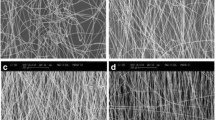Abstract
In this paper, the stress–strain behavior of polyamide (PA) and poly(lactic-co-glycolic acid) (PLGA) nanofiber yarns was modeled by the modified spring-dashpot Vangheluwe’s model. The modified three-element viscoelastic model was employed to describe the mechanical behavior of the nanofiber yarn subjected to a tensile load. The model was fitted to experimental data by the curve fitting method, and stress–strain curves were simulated for nanofiber yarn with a correlation more than 98%. To validate the model, the obtained data on the tensile properties of nanofiber yarn were investigated. The relationship between theoretical and experimental results showed that the parameters of the model, i.e., spring stiffness and viscosity of dashpot, were related to such mechanical properties of nanofiber yarn as initial modulus and stress.





Similar content being viewed by others
References
Mahdi MA, Yousefi SR, Jasim LS, Salavati-Niasari M (2022) Green synthesis of DyBa2Fe3O7.988/DyFeO3 nanocomposites using almond extract with dual eco-friendly applications: photocatalytic and antibacterial activities. Int J Hydrog Energy 47(31):14319–14330
Yousefi SR, Alshamsi HA, Amiri O, Salavati-Niasari M (2021) Synthesis, characterization, and application of Co/Co3O4 nanocomposites as an effective photocatalyst for discoloration of organic dye contaminants in wastewater and antibacterial properties. J Mol Liq 337:116405
Yousefi SR, Ghanbari D, Salavati-Niasari M, Hassanpour M (2016) Photo-degradation of organic dyes: simple chemical synthesis of Ni(OH)2 nanoparticles, Ni/Ni(OH)2 and Ni/NiO magnetic nanocomposites. J Mater Sci Mater Electron 27(2):1244–1253
Yousefi SR, Sobhani A, Alshamsi HA, Salavati-Niasari M (2021) Green sonochemical synthesis of BaDy2NiO5/Dy2O3 and BaDy2NiO5/NiO nanocomposites in the presence of core almond as a cap** agent and their application as photocatalysts for the removal of organic dyes in water. RSC Adv 11(19):11500–11512
Theron A, Zussman E, Yarin A (2001) Electrostatic field-assisted alignment of electrospun nanofibres. Nanotechnology 12(3):384
Dalton PD, Klee D, Möller M (2005) Electrospinning with dual collection rings. Polymer 46(3):611–614
Smit E, Bűttner U, Sanderson RD (2005) Continuous yarns from electrospun fibers. Polymer 46(8):2419–2423
Teo W-E, Gopal R, Ramaseshan R, Fujihara K, Ramakrishna S (2007) A dynamic liquid support system for continuous electrospun yarn fabrication. Polymer 48(12):3400–3405
Lotus A, Bender E, Evans E, Ramsier R, Reneker DH, Chase GG (2008) Electrical, structural, and chemical properties of semiconducting metal oxide nanofiber yarns. J Appl Phys 103(2):024910
Dabirian F, Hosseini S (2009) Novel method for nanofibre yarn production using two differently charged nozzles. Fibres Text East Eur 17(3):45–47
Dabirian F, Hosseini Y, Ravandi SH (2007) Manipulation of the electric field of electrospinning system to produce polyacrylonitrile nanofiber yarn. J Text Inst 98(3):237–241
Sanatgar RH, Borhani S, Ravandi SAH, Gharehaghaji AA (2012) The influence of solvent type and polymer concentration on the physical properties of solid state polymerized PA66 nanofiber yarn. J Appl Polym Sci 126(3):1112–1120
Haghighat F, Ravandi SAH (2014) Mechanical properties and in vitro degradation of PLGA suture manufactured via electrospinning. Fibers Polymers 15(1):71–77
Naraghi M, Arshad S, Chasiotis I (2011) Molecular orientation and mechanical property size effects in electrospun polyacrylonitrile nanofibers. Polymer 52(7):1612–1618
Nachane R, Hussain G (1998) Inverse creep in some textile yarns. Indian J Fibre Text Res 23(1):81–84
Deng M, Zhou J (2003) Effects of temperature and stress level on creep and tensile property of polypropylene sutures. J Appl Polym Sci 90(14):3882–3888
Gao X, Sun Y, Meng Z, Sun Z (2012) Analytical approach of creep behavior of carpet yarn. J Appl Polym Sci 124(2):1160–1167
Ghosh A, Das S, Banerjee D (2013) Simulation of yarn stress relaxation and creep behaviors using genetic algorithm. Indian J Fibre Text Res 38:375–379
Vangheluwe L, Kiekens P (1996) Modelling relaxation behaviour of yarns Part I: extended, nonlinear Maxwell model. J Text Inst 87(2):296–304
Manich AM, Maíllo J, Cayuela D, Gacén J, de Castellar M, Ussman M (2007) Effect of the air-jet and the false-twist texturing processes on the stress–relaxation of polyamide 6.6 yarns. J Appl Polymer Sci 105(5):2482–2487
Vangheluwe L (1993) Relaxation and inverse relaxation of yarns after dynamic loading. Text Res J 63(9):552–556
Manich A, Marino P, De Castellar M, Saldivia M, Sauri R (2000) Viscoelastic modeling of natural and synthetic textile yarns. J Appl Polym Sci 76(14):2062–2067
Vangheluwe L (1992) Influence of strain rate and yarn number on tensile test results. Text Res J 62(10):586–589
Hosseini Ravandi S, Hassanabadi E, Tavanai H, Abuzade R (2012) Mechanical properties and morphology of hot drawn polyacrylonitrile nanofibrous yarn. J Appl Polym Sci 124(6):5002–5009
Mortan W, Hearle L (1975) Physical properties of textile fibers. Rheology, Chapter 16. Heinemann, London, pp 357–413
Williams ML, Landel RF, Ferry JD (1955) The temperature dependence of relaxation mechanisms in amorphous polymers and other glass-forming liquids. J Am Chem Soc 77(14):3701–3707
Acknowledgements
The author would like to acknowledge the financial support of the Isfahan University of Technology for sabbatical leave.
Author information
Authors and Affiliations
Corresponding author
Ethics declarations
Conflict of interest
The authors declare no potential conflict of interest with respect to the research, authorship, and/or publication of this article.
Additional information
Publisher's Note
Springer Nature remains neutral with regard to jurisdictional claims in published maps and institutional affiliations.
Rights and permissions
Springer Nature or its licensor holds exclusive rights to this article under a publishing agreement with the author(s) or other rightsholder(s); author self-archiving of the accepted manuscript version of this article is solely governed by the terms of such publishing agreement and applicable law.
About this article
Cite this article
Ravandi, S.A.H., Sadrjahani, M. The effect of thermal setting, solvent type, and concentration on the tensile behavior of electrospun PLGA and polyamide nanofiber yarns simulated with the modified viscoelastic model. Polym. Bull. 80, 8339–8354 (2023). https://doi.org/10.1007/s00289-022-04449-y
Received:
Revised:
Accepted:
Published:
Issue Date:
DOI: https://doi.org/10.1007/s00289-022-04449-y




